How Much Clearance Is Necessary Around an Outdoor AC Unit?
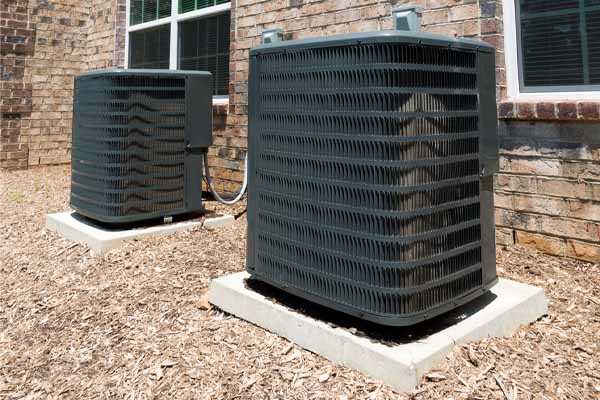
Air conditioners require ample space to function efficiently and prolong their lifespan. HVAC technicians must follow industry guidelines when installing new AC systems. However, the effort should not stop there. Homeowners should also regularly monitor the distance between their outdoor AC units and any surrounding landscaping, as they may encroach over time. Inspect the perimeter throughout the year. The recommended clearance for each AC unit will vary depending on the specific circumstances. Keep reading to discover more about space required for AC outdoor unit.
Importance of Allowing Ample Clearance Around the Outdoor AC Unit
Contents
- 1 Importance of Allowing Ample Clearance Around the Outdoor AC Unit
- 2 Call Townsend Energy For Your Air Conditioning Requirements
Insufficient airflow can lead to a range of problems with HVAC systems, as they require unobstructed space in and around the outdoor unit to receive adequate air. Some of the issues that may arise due to improper clearance include:
- Reduced AC Energy Efficiency: Without an adequate air supply, the cooling system may attempt to compensate by operating at a higher intensity. This increased workload will result in higher energy consumption and, ultimately, higher utility expenses.
- Sub-Optimal Indoor Cooling: Despite being turned on, the air conditioner may not generate sufficient cooling power for the house, causing the occupants to still feel warm and uncomfortable.
- System Component Overheating: If the hot air within the outdoor unit cannot dissipate rapidly, it could cause the HVAC system to overheat, leading to premature equipment failure and the need for repairs.
Related Article: Why Is HVAC Airflow So Important For My Home?
How Much Clearance Is Necessary Around An Outdoor Air Conditioning Unit?
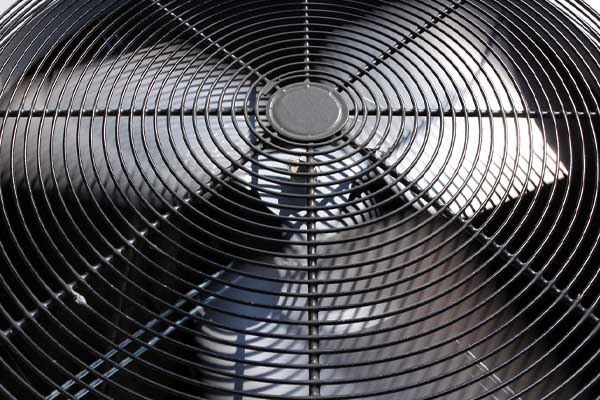
The function of the outdoor air conditioning unit is to expel the indoor heat to the exterior surroundings, which can be achieved only if there is sufficient airflow surrounding the coils. To ensure effective operation, maintain a clearance of at least one foot around the unit, although some manufacturers may suggest more. Refer to the owner’s manual for specific instructions, or consult with your HVAC contractor. The minimum clearance requirements can also be affected by the type of obstructions in the immediate vicinity. Here are some of the typical issues to consider:
Construction Obstructions
Structures like walls and fences that surround the property can impede the flow of air if they are constructed with solid materials. Do not place the outdoor unit close to them, as it can result in inadequate cooling of the house. The compressor may also experience damage due to restricted airflow over time. To ensure adequate airflow and cooling, maintain a minimum separation of at least two feet from these obstructions. This distance allows the unit to draw air efficiently and cool the hot coils.
Related Article: Follow These Simple Tips To Improve Your Home’s Indoor Air Quality
Landscaping Obstructions
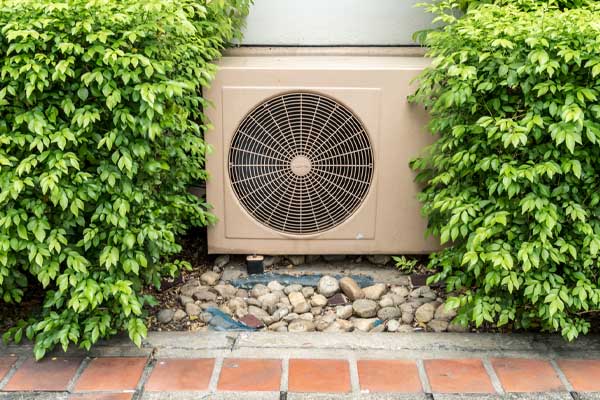
Many homeowners find the appearance of the outdoor AC unit displeasing because it may not blend well with the house’s design. Some may conceal it by planting additional shrubs and placing potted plants around it for a more visually appealing exterior. This could lead to potential issues within the house, such as limited airflow, reduced HVAC system efficiency, subpar performance, and damage to components. Keep at least a two feet clearance around the unit. Since plants grow rapidly, homeowners must regularly trim the surrounding area.
Mechanical Obstructions
The outdoor AC unit is most affected by certain obstructions which pose significant problems. These may include heating appliance vents, kitchen exhaust, and clothes dryers. If positioned too closely, these may lead to issues with airflow. In some instances, they may even be hazardous, as with oil tank fill valves and gas vents. A substantial distance of at least four feet is recommended to ensure safety, though keeping them as far away as possible is best. HVAC installers will attempt to locate a suitable area in another section of the property.
Related Article: Debunking the Myths: The Truth About Central Air Conditioners
Outdoor Air Conditioner Unit & Overhead Clearance
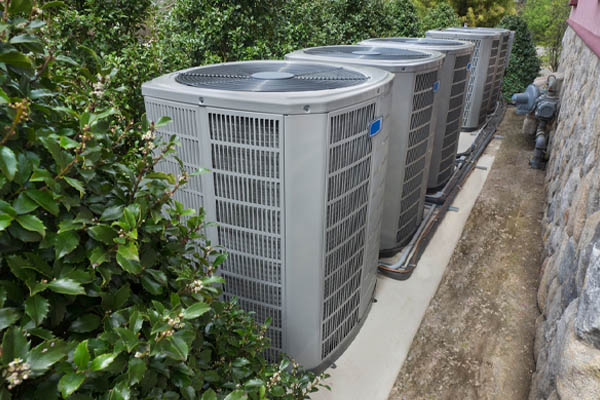
Remember that the top of the AC unit is just as critical. Once you have cleared the sides, shift your attention to anything above the unit. Most current models release hot air upwards, so any obstruction in this area will cause hot air to circulate back down, resulting in overheating. Common culprits are debris like dry leaves and branches, nearby shrubs that have grown over the unit, decks built above the outdoor AC with insufficient spacing between the top and the deck boards, and decorative covers or low roof overhangs. To avoid such issues, keep a minimum overhead clearance of 8ft.
Related Article: How Does An Air Conditioner Tune-Up Save Me Money?
Spacing Between Two Outdoor Condensing Units
Professional installers must carefully consider the distance between two or more outdoor units. The proximity of the units can hinder each other’s air intake, making it challenging for the air conditioner to cool the house. If one unit pulls in hot air from the other, it may suffer from overheating. A minimum spacing of 4ft between the units is essential.
Spacing For An Outdoor Heat Pump
Heat pumps can be a reliable option for heating and cooling in regions with mild climates. Adequate clearance around the outdoor equipment is crucial. Homeowners should exercise extra caution during winter as snow and ice may accumulate, covering the heat pump. To ensure optimal system efficiency, the coils should always be kept above the snowpack, and clearing snow around the unit should be a regular habit. Occasionally, snow may penetrate the unit, necessitating cleaning. If homeowners are hesitant to perform this task, they can seek assistance from HVAC technicians.
Related Article: Overcharged AC: How To Spot & Solve The Problem
Site Inspection Before HVAC Installation
Before installing the HVAC system, technicians will conduct a site visit to identify optimal locations for the outdoor unit. They will assess the property layout and identify any potential obstacles that may impact the system’s performance. Based on their findings, they will determine the appropriate clearance required on all sides and use this information to design and install the unit for optimal results.
To ensure adequate spacing and minimize the risk of costly errors or performance issues, homeowners can take a proactive approach by consulting with their HVAC contractor about clearance requirements before installation. This will enable them to learn more about the subject and actively contribute to the process.
Related Article: How To Avoid Heat Exhaustion & Heat Stroke When Your AC Goes Down
Conclusion
Having enough clearance for the AC is crucial during an HVAC system installation. Enlist the services of certified air conditioning technicians to avoid any future issues. Their expertise in careful planning and execution will ensure the best possible outcome.
Related Article: Common Causes Of Air Conditioner Short Cycling
Call Townsend Energy For Your Air Conditioning Requirements
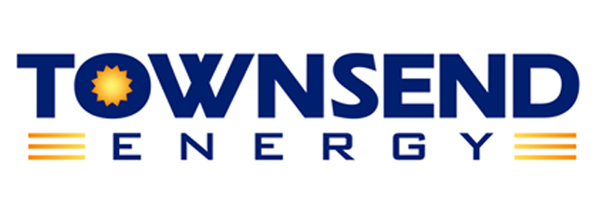
At Townsend Energy, we provide exceptional heating and cooling services to Northeastern Massachusetts, Southern New Hampshire & Maine residents. Our team comprises highly skilled technicians with licensed certifications, ensuring top-notch HVAC tune-ups, repairs, installations, and replacements. You can trust us to service your HVAC system with our techs’ extensive knowledge and experience.
Our heating and cooling service costs are among the most competitive in the area, and we guarantee your satisfaction. Our maintenance services can enhance comfort, increase energy efficiency, and reduce home cooling expenses. Whether you require HVAC repairs or a new system installation, we can suggest the best options within your budget. All our HVAC work comes with a satisfaction guarantee. Call us today to schedule an air conditioner tune-up or service appointment with Townsend Energy. We provide free, in-home estimates.
Contact us now at (800) 722-4101 to find out more! Click the link to view our service area.
